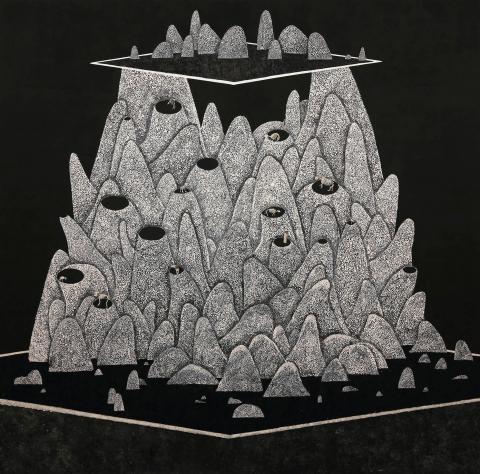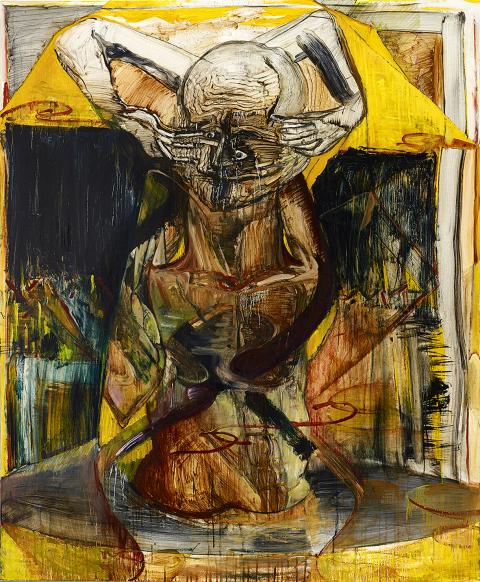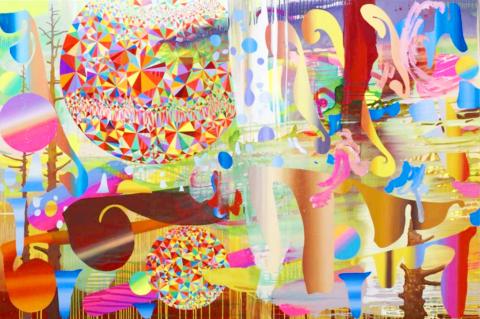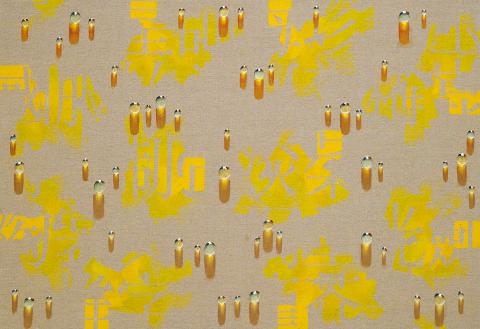Jhong Jiang-ze’s (鍾江澤) wonderfully distorted abstract portraitures are currently on display at Mind Set Art Center in the exhibition, Recent Works by Jhong Jiang-ze (鍾江澤新作). His paintings — many of which depict mangled human limbs set against colorful backdrops — are intriguing and frightening at the same time. While Jhong maintains that he is influenced by Buddhist and Taoist beliefs — including the longing of human beings to achieve oneness with nature — his artwork also exhibits a Western expressionist sentiment that’s kind of akin to that of Edvard Munch’s paintings which explore the darker facets of human psychology.
■ Mind Set Art Center (安卓藝術), 16-1, Xinsheng S Rd Sec 3, Taipei City (台北市新生南路三段16-1號), tel: (02) 2365-6008. Open Tuesdays to Sundays from 2pm to 6pm
■ Until Dec. 30

Photo courtesy of In River Gallery
Come After Magic is an enticing psychedelic exhibition by Japanese artists Satoshi Ohno and Takuro Kuwata at Taipei’s Aura Gallery. Ohno, who lives by the foot of Mount Fuji, has no trouble finding inspiration for his colorful, abstract paintings which evoke a childlike curiosity with nature that’s refreshing as it is mesmerizing. He sees beauty in the geometric properties in flowers and plants, reinterpreting it as kaleidoscopes of colors. Meanwhile, Kuwata’s work achieves much of the same effect, albeit through porcelain. He uses the traditional glaze technique of kairagi (cracked glaze from firing) and ishihaze (literally stone explosion) to produce cracked and contorted pop art-style tea cups and kettles. The ceramics allude to traditional Japanese tea ceremonies but with a modern, somewhat hipster-come-flippant flair.
Also on display at Aura Gallery are the works of Chinese photographer You Li (游莉). Entitled All That Is, the exhibition features patchwork images that symbolize events and memories from You’s life. The objects she photographs are not just laden with intensely personal meaning, but through them, the viewer can also piece together a larger history, namely the history of a neighborhood, city or even a nation. This exhibition marks a departure from You’s previous works which documented the scenery of northeast China. Nevertheless, the same sense of resounding simplicity still permeates her work.
■ Aura Gallery Taipei (亦安畫廊台北), 313, Dunhua N Rd Sec 1, Taipei City (台北市敦化南路一段313號); tel: (02) 2752-7002. Open Tuesdays to Saturdays from 12pm to 7pm

Photo courtesy of Mind Set Art Center
■ Both exhibitions until Jan. 9
South Korean artists share the limelight at Metaphysical Art Gallery this week in an exhibition entitled New Light Catch Your Eye (另眼相看). From paintings and sculptures to video and installation, the exhibition features the artwork of several artists who were pivotal in the establishment of modern Korean art from the 60s to the present day. Included in the lineup is kinetic installation artist Choe U-ram whose giant, insect-like creatures have illuminated entire rooms in art galleries from New York to Shanghai. Also on display are Kim Tschang-yeul’s paintings of water droplets set against zen-like backdrops with Chinese characters. Spanning several decades, Kim’s paintings are calm and therapeutic. The Japanese-educated Lee U-fan is most well-known for his minimalist style of art that combines natural and industrial materials, but the gallery also has some of his paintings up on display.
■ Metaphysical Art Gallery (形而上畫廊), 7F, 219, Dunhua S Rd Sec 1, Taipei City (台北市敦化南路一段219號7樓), tel: (02) 2771-3236. Open Tuesdays to Sundays from 11am to 6:30pm

Photo courtesy of Aura Gallery
■ Until Jan. 24
Tao Kang’s (陶綱) black-and-white paintings of various bestial creatures caught in maze-like structures are currently on display at Taipei’s In River Gallery. Entitled Beasts/Cornered (困獸之鬥), the exhibition transports viewers to a fantastical, otherworldly realm while also keeping us firmly grounded by reminding us that it’s okay to feel emotions such as frustration and desire. Far from being frightening or chaotic, Tao’s paintings are calming and reassuring — sure, there may be labyrinths to maneuver through and mountains to scale, but it’s not that daunting if you have a little faith in yourself.
■ In River Gallery (穎川畫廊), 2F, 45, Renai Rd Sec 1, Taipei City (台北市仁愛路一段45號2樓), tel: (02) 2357-9900. Open Tuesdays to Sundays from 1pm to 8pm

Photo courtesy of Metaphysical Art Gallery
■ Until Jan. 30
With the rise of digital art, video installation, sound art and the like, traditional mediums such as silkscreen printing and engraving are arguably on the decline. VT Art Salon aims to revive public interest in these traditional mediums in its latest exhibition, In Print We Trust Artist and Silk Screen Print Exhibition (有印良品 ─ 藝術家與絹印作品展), which features the works of 13 Taiwanese artists. The exhibition highlights the fact that print is not dead. These techniques are applied not just to the pages of newspapers and magazines, but printed on clothes, signboards and greeting cards as well.
■ VT Art Salon (非常廟藝文空間), B1, 47 Yitong St, Taipei City (台北市伊通街47號B1), tel: (02) 2516-1060. Open Tuesdays through Thursdays from 1:30pm to 9pm, and Fridays and Saturdays from 1:30pm to 10pm
■ Until Feb. 20

The canonical shot of an East Asian city is a night skyline studded with towering apartment and office buildings, bright with neon and plastic signage, a landscape of energy and modernity. Another classic image is the same city seen from above, in which identical apartment towers march across the city, spilling out over nearby geography, like stylized soldiers colonizing new territory in a board game. Densely populated dynamic conurbations of money, technological innovation and convenience, it is hard to see the cities of East Asia as what they truly are: necropolises. Why is this? The East Asian development model, with

June 16 to June 22 The following flyer appeared on the streets of Hsinchu on June 12, 1895: “Taipei has already fallen to the Japanese barbarians, who have brought great misery to our land and people. We heard that the Japanese occupiers will tax our gardens, our houses, our bodies, and even our chickens, dogs, cows and pigs. They wear their hair wild, carve their teeth, tattoo their foreheads, wear strange clothes and speak a strange language. How can we be ruled by such people?” Posted by civilian militia leader Wu Tang-hsing (吳湯興), it was a call to arms to retake

This is a deeply unsettling period in Taiwan. Uncertainties are everywhere while everyone waits for a small army of other shoes to drop on nearly every front. During challenging times, interesting political changes can happen, yet all three major political parties are beset with scandals, strife and self-inflicted wounds. As the ruling party, the Democratic Progressive Party (DPP) is held accountable for not only the challenges to the party, but also the nation. Taiwan is geopolitically and economically under threat. Domestically, the administration is under siege by the opposition-controlled legislature and growing discontent with what opponents characterize as arrogant, autocratic

When Lisa, 20, laces into her ultra-high heels for her shift at a strip club in Ukraine’s Kharkiv, she knows that aside from dancing, she will have to comfort traumatized soldiers. Since Russia’s 2022 invasion, exhausted troops are the main clientele of the Flash Dancers club in the center of the northeastern city, just 20 kilometers from Russian forces. For some customers, it provides an “escape” from the war, said Valerya Zavatska — a 25-year-old law graduate who runs the club with her mother, an ex-dancer. But many are not there just for the show. They “want to talk about what hurts,” she